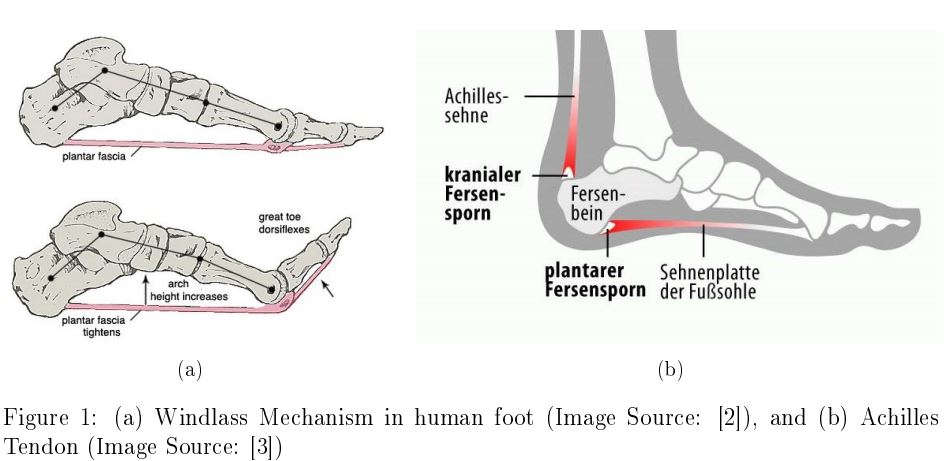The human foot, like most biological structures, has an exceedingly complex and intricate design. A significant challenge for biomechanists and biologists alike is to identify the function of various morphological features that constitute the human foot. Two of such salient morphological features are namely the Windlass Mechanism and Achilles Tendon. The windlass mechanism is a simplified mechanical model of the arched structure of the human foot (i.e. planter fascia) and a tendon structure that spans the foot and connects between the heel and the toe (See Fig. 1(a)). The windlass mechanism is hypothesized to be important for supporting the foot's weight-bearing ability. The windlass mechanism is also said to support other leg functions, such as hopping and running. The other salient morphological feature of the human foot, the Achilles tendon is a tendon structure that connects the calf muscles to the heel of the foot (See Fig. 1(b)). The Achilles tendon helps lift the heel off the ground and therefore is hypothesized to be useful for walking, running, and jumping.

The goal of this project is to study the functional role of the two salient human foot features, namely the windlass mechanism and the Achilles Tendon, with the help of multibody dynamic simulation of the human foot and leg. In particular, the role of the windlass mechanism and Achilles tendon in hopping (and potentially walking) would be investigated to test some of the hypotheses found in the literature regarding the role of these morphological features (A nice example of such a hypothesis is given in [1]).
The thesis will include:
- Literature Review
- Study the structure of human feet and legs and develop a simplified multibody dynamic model consisting of the windlass mechanism and Achilles tendon.
- Derive the equations of motion for the leg model and implement an event-based (hybrid) dynamic simulation in MATLAB to model the unilateral contact between the foot and the ground.
- Use the simulation to test some of the hypotheses related to the role of the windlass mechanism and Achilles Tendon in hopping (and possibly walking).
- Prepare a report with all experimental results and conclusions.
References
[1] Liu X., Duan Y., Hitzman A., Xu Y., Chen T., Ikemoto S., Hosoda K., 2018 Using the foot windlass mechanism for jumping higher: a study on bipedal robot jumping Robotics and Autonomous Systems 85-91.
[2] https://www.physio-pedia.com/Windlass_Test
[3] https://commons.wikimedia.org/wiki/File:Fersensporn_Anatomie.jpg
